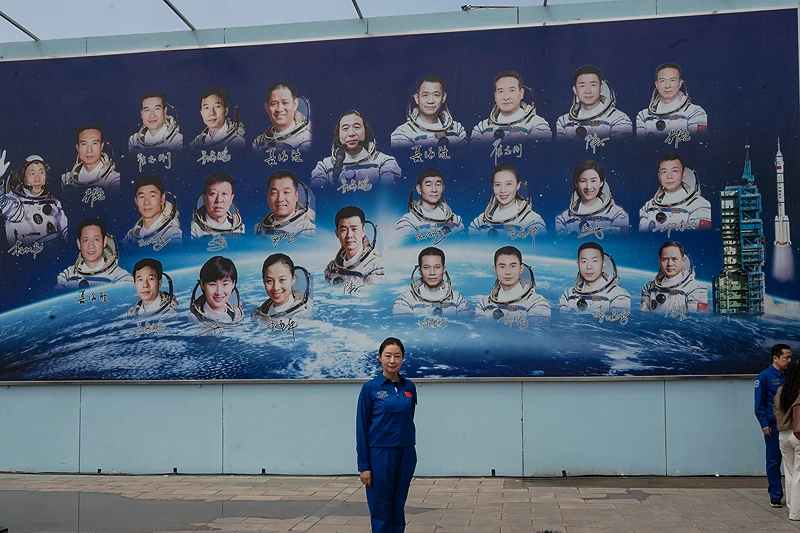

OAN’s Brooke Mallory
5:25 PM – Monday, May 29, 2023
According to Chinese officials, China’s expanding space program plans to build its own orbiting space station and send their astronauts to the moon by 2030.
Advertisement
The race between China and the United States to achieve new space milestones and their quest for influence over world affairs are reflected in Monday’s statement.
However, it is believed that the United States currently has a significant competitive advantage over China, at least currently, due to American spending, supply chains, and capabilities.
At a press conference, the deputy director of China’s space agency confirmed the twin objectives but did not provide a deadline.
The organization also unveiled three astronauts who will launch on Tuesday morning and travel to the nation’s space station. They will be swapping out the six-month-old crew that was on the orbiting station.
China is first preparing for a “short stay on the lunar surface and human-robotic joint exploration,” said Lin Xiqiang, deputy director of the Chinese Manned Space Agency, during a discreet press conference by the military-run program.
“We have a complete near-Earth human space station and human round-trip transportation system,” complemented by a process for selecting, training, and supporting new astronauts, he said. A schedule of two crewed missions a year is “sufficient for carrying out our objectives,” Lin said.
When the third component was attached back in November, it was declared that the Tiangong space station was finally complete.
In order to gain support for scientific research and give the crew better living and working conditions, a fourth module will be deployed “at an appropriate time,” according to Lin.
The three astronauts who will be traveling to space on the Shenzhou 16 craft will momentarily coexist with the three who have been living on the station for the past six months, leading experiments and setting up equipment both inside and outside the vehicle.
For the first time, a civilian is part of the new team. Prior crew members were all members of the People’s Liberation Army, the nation’s dominant Communist Party’s armed forces.
In addition to mission commander Jing Haipeng and spacecraft engineer Zhu Yangzhu, the appointed payload specialist will be Gui Haichao, a professor at Beijing’s premier aerospace research center.
Jing told reporters at the launch site near Jiuquan, in the northwest, that the mission represented “a new stage of application and development” for China’s space program.
“We firmly believe that the spring of China’s space science has arrived, and we have the determination, confidence, and ability to resolutely complete the mission,” said Jing, a major general with three previous flights worth of experience.
China became the third nation after the USSR and the U.S. to send a human into space in 2003 with its first manned space mission. Following its exclusion from the International Space Station, China constructed its own space station, largely as a result of American concerns regarding China’s close ties to the PLA in its space programs.
The United States and China, the two largest economies in the world and rivals for diplomatic and military influence, are increasingly seen as competing in the field of space. One is a highly centralized, one-party state, while the other is a democracy where the partisan divide largely disappears over matters of relations with China and space exploration.
By the end of 2025, NASA plans to send people to the moon, with their focus on the south pole, where perpetually shadowed craters are thought to be teeming with frozen water.
Both nations are considering the idea of building permanent crewed outposts on the moon, which raises concerns regarding rights and interests on the lunar surface. While China says it welcomes foreign collaborations, those have thus far been limited to scientific research. U.S. legislation severely restricts cooperation between the two countries’ space programs.
Li Yingliang, the technology director of the Chinese crewed space flight organization, stated in a speech delivered on Monday afternoon in Jiuquan that China aimed for increased international cooperation, including that with the United States.
“Our country’s consistent stance is that as long as the goal is to utilize space for peaceful purposes, we are willing to cooperate and communicate with any country or aerospace organization,” Li said.
“Personally, I regret that the U.S. Congress has relevant motions banning cooperation in aerospace between the U.S. and China. I very much regret that personally,” he continued.
In addition to their lunar projects, the United States and China have both successfully landed rovers on Mars.
Other nations and organizations, including Israel and the European Union, as well as India and the United Arab Emirates, are also organizing lunar expeditions.
Between 1969 and 1972, the United States flew six crewed trips to the moon, three of which utilized a drivable lunar rover that China claims it is currently constructing through private sector tenders.
China’s space program has advanced steadily and cautiously, reflecting the country’s enormous growth in economic strength and worldwide influence since the 1980s, even though America currently runs more spaceports and has a much bigger network of international and commercial partners than China.
Stay informed! Receive breaking news blasts directly to your inbox for free. Subscribe here. https://www.oann.com/alerts






Be the first to comment